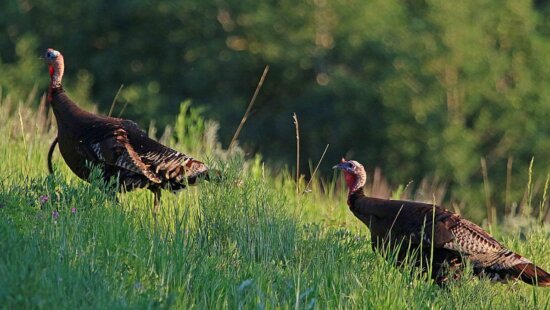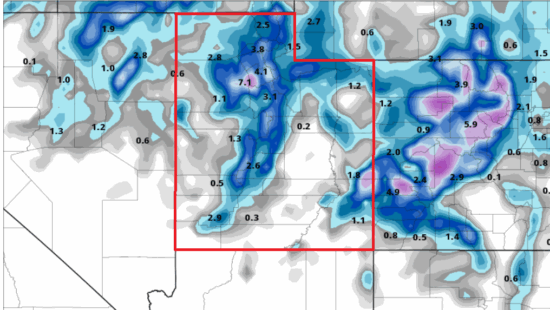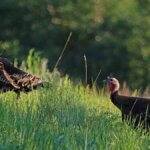News
Measles outbreak hasn’t hit Utah yet, but health officials are bracing for when it does
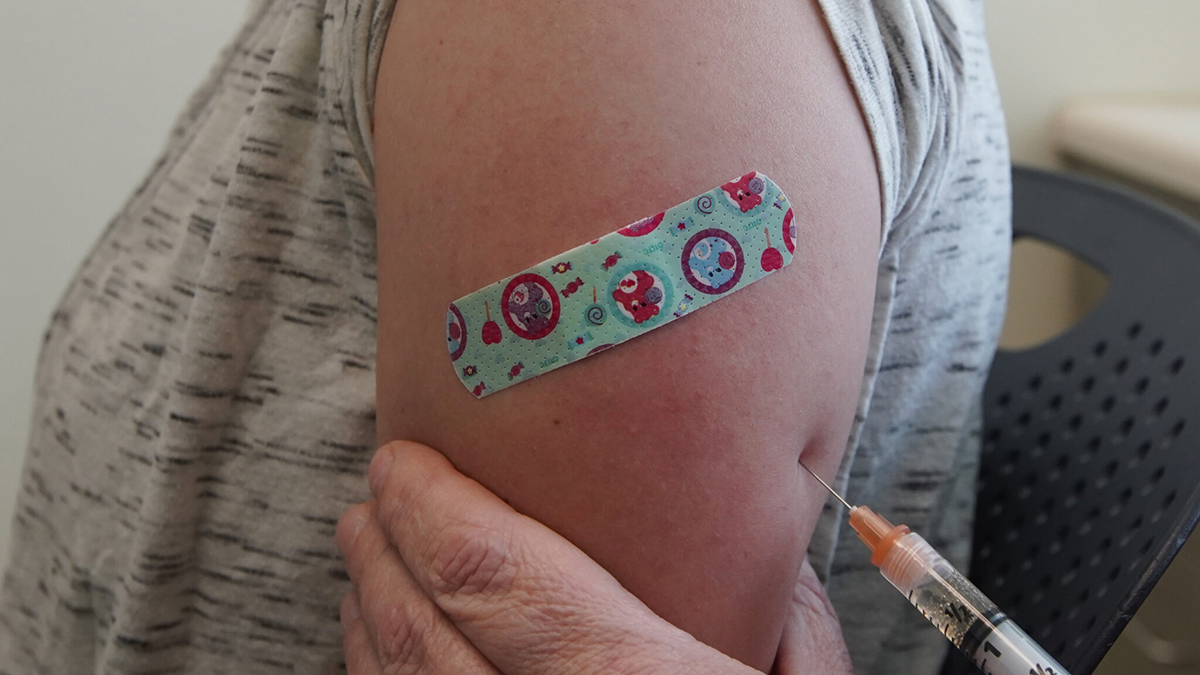
A nurse gives a measles, mumps and rubella virus vaccine made by Merck at the Utah County Health Department in Provo, Utah. Photo: George Frey
For years, Utah’s early childhood vaccination rates have been declining
SALT LAKE CIY, Utah – Amid national outbreaks, a confirmed measles case hasn’t yet hit Utah — but as nearby states report cases, the highly contagious virus could be closing in.
Meanwhile, Utah’s childhood vaccination rates have been on a steady decline for years.
Local and state public health officials say it’s likely a matter of time before the Beehive State gets its first measles case, and they’re bracing for if or when it happens.
“We’re always looking at cases in other states,” Rich Lakin, immunization program manager at the Utah Department of Health and Human Services, told Utah News Dispatch this week. “We’ve been ready for a long time, but so far so good. We haven’t had any cases here in Utah.”
But to be prepared, Lakin said state public health officials are working with local health departments, clinics, and physicians to ensure they know how to quickly identify a measles case and properly handle it when someone comes in for treatment.
Nic Rupp, spokesperson for the Salt Lake County Health Department, said county health officials “monitor the status nationwide every day.”
“We will likely see a case locally as infections get closer geographically and as people travel more this summer,” Rupp said.
In the meantime, he said the Salt Lake County Health Department is encouraging populations with low rates for the MMR vaccine (which protects against measles, mumps and rubella) to get up to date on their shots as part of efforts to minimize the spread of the virus “when a case does show up here.”
The last reported measles infection in Utah was reported in March 2023, according to state health officials.
“A person who was not vaccinated traveled outside the U.S. and brought measles back to Utah,” the state’s website says. “We do not believe anyone else in Utah got measles from this person.”
Before that 2023 case, three people in Utah had measles in February 2017.
Outbreaks
So far this year Utah’s neighboring state of Colorado has confirmed five cases, according to NBC News’ outbreak tracker. New Mexico has seen 79 cases, 14 of which have been reported in the last four weeks. In Texas, 753 cases have been confirmed, with 60 reported in the last four weeks.
As of Thursday, a total of 1,088 confirmed measles cases have been reported in 2025 from 33 states, according to the U.S. Centers for Disease Control and Prevention. Those include Alaska, Arkansas, California, Colorado, Florida, Georgia, Hawaii, Illinois, Indiana, Iowa, Kansas, Kentucky, Louisiana, Maryland, Michigan, Minnesota, Missouri, Montana, Nebraska, New Jersey, New Mexico, New York City, New York State, North Dakota, Ohio, Oklahoma, Pennsylvania, Rhode Island, Tennessee, Texas, Vermont, Virginia and Washington.
Fourteen outbreaks have been reported so far in 2025, and 90% of those confirmed cases (977 of 1,088) have been outbreak associated, according to the CDC. For comparison, 16 outbreaks were reported during 2024, and 69% of cases (198 of 285) were outbreak associated.
Utah’s vaccination rate is dropping, on pace with regional declines
For several years now, Utah health officials have tracked a decline in the state’s early childhood MMR vaccinations.
According to the state’s immunization dashboard, the percentage of Utah children that received at least one dose of the MRR vaccine at 24 months old has dropped from 94.5% of those born in 2019 to 89.8% of those born in 2021.
“It has dropped,” Lakin said.
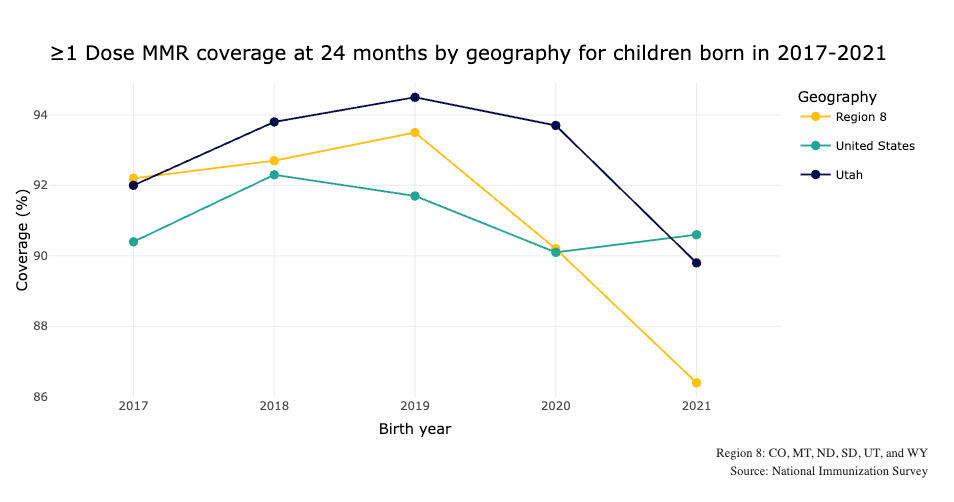
He pointed out that the region, which also includes the states of Colorado, Montana, North Dakota, South Dakota and Wyoming, has gone from a 98.3% for the birth year of 2019 “all the way down to 86.4%.”
“So the region as a whole is not doing very well,” he said. That concerns public health officials because travelers tend to visit nearby states, “anytime you get cases in other states, then it increases our chances of getting a measles case here in Utah.”
The ideal vaccination rate to reach herd immunity protection against measles is 95%, he said. Young children are also most at risk if they contract the virus.
“The thing that would concern us the most would be for an adult to get measles, and then you pass it to a 6-month-old that hasn’t been vaccinated yet,” he said.
The state’s dashboard is currently using the latest available data from 2023, Lakin said, but state officials are working to update it soon with 2024 data. Health officials expect that Utah’s immunization rate has continued to decline.
“The expectation is, yes, it is continuing to decline,” he said, though he added, “by how much, I do not know yet.”
State 2023 data shows public school districts tend to have higher immunization rates than charter schools. In Salt Lake County, Canyons, Granite, Jordan, Murray and Salt Lake City school districts, all had more than 95% immunization rates for the second dose of MMR vaccine in K-12 schools, compared to 91.8% in charter schools.
However, according to that data, only 92.3% of kindergartners in Salt Lake County are up to date on measles vaccination — below the ideal 95% herd immunity threshold.
Last year, Axios reported Utah has one of the nation’s highest rates of childhood vaccine waivers. Religious exemptions accounted for the fastest-rising share of exemptions since before the pandemic, accounting for 13% of Utah’s waivers last year, up from 5.9% in 2019, according to a state report released last year. The vast majority, however, are attributed to “personal belief,” accounting for 84.9% of the waivers in the 2023 to 2024 school year.
Measles vaccine is safe and saves lives
Given the troubling pattern of declining vaccination rates across Utah and other states amid deepening distrust of institutions in the U.S., Lakin acknowledged its “difficult” to encourage people to vaccinate their children, but he said health officials will continue to try to ensure Utahns get accurate information.
“Look at the history,” he said, adding that back in the 1800s, “if your child lived to be an adult, you were very happy. Because they either got smallpox or they got measles or they got mumps, or they got rubella, tetanus, or diphtheria. … I mean, think of all these vaccine preventable diseases that we just don’t see anymore, and it’s because of vaccinations.”
Lakin said “unfortunately people are losing sight of what these vaccinations are doing and getting the wrong information in such a fast-paced world that we live in now.”
“They’re not getting the right information anymore,” he said. “That’s what our continued message is — that vaccinations have been one of the greatest public health achievements we have seen, and we want to continue to keep people safe through vaccinations.”
In a news release issued back in February — after Texas announced the first death of a school-aged child from measles — the Salt Lake County Health Department urged people to ensure they’re protected.
“For decades, the MMR vaccine has been proven safe and effective,” said Dorothy Adams, executive director of the Salt Lake County Health Department. “Ensuring now that you and your loved ones are adequately protected will help prevent serious illness in our community if this current multistate measles outbreak spreads to Utah.”
Measles is one of the most contagious viruses known, and it can be so easily spread that people who are not immune have a 90% chance of catching it if they go near an infected person. Someone with measles can spread it to others even before they know they are ill, and the virus can linger in the air for up to two hours after an infected person has left the area.
Salt Lake County health officials said the best protection against measles is to be immunized with two doses of the MMR vaccine, which can prevent more than 97% of measles infections. In the remaining 3% of cases — when a fully vaccinated person catches measles — the symptoms are milder, the illness is shorter, and the infected person is less likely to spread it.
Unvaccinated people, including children who are too young to be vaccinated, are more likely to experience severe complications from a measles infection.
How to know if you’re up to date on measles shots
Measles vaccine recommendations vary based on age and vaccination history. Here’s what public health experts recommend:
- Children should receive two doses of measles vaccine: one dose at 12 to 15 months of age and another at 4 to 6 years.
- Adults born before 1957 generally do not need to be vaccinated because they are likely already immune to measles due to widespread infection and illness before the measles vaccine became available in 1963.
- Adults who were vaccinated before 1968 should have a second dose because the vaccine used from 1963 to 1967 was less effective than the current vaccine, which became available in 1968.
- Adults who were vaccinated in 1968 or later are considered fully protected whether they have one or two doses, though certain higher risk groups (college students, health care workers, international travelers) should have two doses.
Written by Katie McKellar for Utah News Dispatch
















